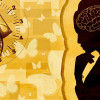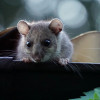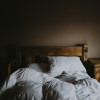Photon BECs: making condensed light
Interview with
Imperial College London physicist Rob Nyman is making Bose-Einstein condensates out of photons, particles of light. Chris Smith asked him how it works...
Rob - The wonderful thing about the prediction of Bose-Einstein condensation is it doesn't make any particular comment about what kind of particles they are, other than that they have to be rigorously identical to each other. As long as you can make rubidium particles identical to each other, in combination with coldness and denseness, you can make them into a Bose-Einstein condensate. And the same is true of particles of light: photons. But making them cold and dense is the hard thing. Cold turns out to be a relative thing, and for photons cold can be room temperature, if you could only make them come to equilibrium without them disappearing. So we have to trap them somehow. And the way we trap photons is between a pair of very high-reflectivity mirrors, perhaps one millionth of a metre apart.
Chris - So let me get my head around this then. You put some light between two reflective surfaces. How do we then turn that into something that's cold? How can light have temperature? ‘Cause surely if it's got energy, it's got temperature; and light is energy, isn't it?
Rob - This is true. We have a problem that actually the matter around us emits and absorbs light and it does so in a somewhat randomised way. And if we tried to cool a black box down - that’s the way we typically describe it - it would simply decrease the number of particles. And so we wouldn't... while it gets cold, the density would get low and we'd never achieve that high density and low temperature. So we have to do a special trick, which is we put a dye, a fluorescent dye in between our mirrors; literally the same kind of dye you would use in a fluorescent highlighter pen. And the light is absorbed by the dye and then re-emitted. And the combination of absorption and emission, this exchange of particles with a reservoir of matter; that allows the light to come to thermal equilibrium at room temperature, without the number increasing or decreasing. And now we can just change the number. The way we do this is we essentially shine an overpowered laser pointer at our pair of mirrors until the density gets high enough that the combination of density and temperature is now appropriate to make a Bose-Einstein condensate.
Chris - If you make one of these, what does it actually look like?
Rob - So the images of photon Bose-Einstein condensates in my laboratory look like a kind of a fuzzy spot around, which is mostly greenish-yellow, and in the middle is a bright yellow spot. The greenish fuzz around is what we call the thermal component and the bright yellow spot is the Bose-Einstein condensate in the middle.
Chris - Now Rob, you've done this with photons, these are packets of light; but there's also these notional graviton particles that enable gravity to be conveyed from one body to another allegedly. I mean we've got no proof of them, have we, but would they potentially also therefore form a Bose-Einstein condensate? And if they did, what would it look like?
Rob - In principle? Yes. One could form a Bose-Einstein condensate out of any particles, which first of all need to be rigorously identical, like gravitons, the particles of gravity. And secondly they need to be brought to thermal equilibrium without their number increasing or decreasing. How one would bring gravitons to thermal equilibrium, I'm not clear; I don't see a particular configuration, but I don't see any reason why one couldn't either. If one could, then what they would look like would be a very large scale wave of gravity. Very much like the gravitational waves emitted by for example, orbiting black holes.
Chris - In your experiments, the thing that I'm slightly struggling with is how you manage to make sure that your light doesn't soak into the mirrors, give up its energy and just disappear. And also how you don't end up with the mirrors being warm enough to add just more photons of their own and confuse your results. How do you keep it clean?
Rob - They are extremely good quality mirrors. They reflect something like 99.997%, which means the light bounces around perhaps 30,000 times before it is eventually transmitted through the mirrors. That's enough times for the thermal equilibrium processes of absorption and emission with the dye to happen. So all that matters is that the mirrors are good enough, and in this case, it turns out to be about as good as you can get them buying it from the very best company who can make these things.
Chris - And while it's lovely, what's the point? What are we learning by doing this? And what might be the application of being able to make these photon based Bose-Einstein condenses?
Rob - One of the points is that Bose-Einstein condensation is a phase transition in very much the same way as a vapour can condense to a liquid. That's why it's called condensation. So we can use photon Bose-Einstein condensation to understand what a phase transition is. That's revisiting textbook definitions, reunderstanding, but that's still very academic. The other thing is I'll maybe turn your question about applications backwards. And it turns out that there is circumstantial evidence that photon Bose-Einstein condensation is happening inside devices called VCSELs: vertical cavity surface emitting lasers. Now they sound esoteric, but there's one of those in pretty much every single computer mouse. So it's not absolutely sure, but it seems like photon Bose-Einstein condensation has been going on in billions of devices for a decade and more now. And we just haven't realised it.









Comments
Add a comment